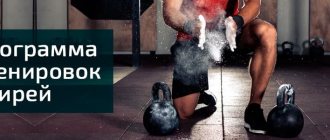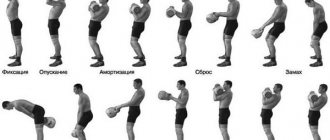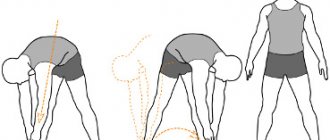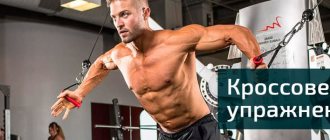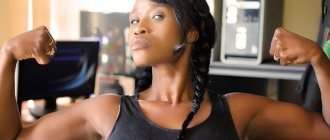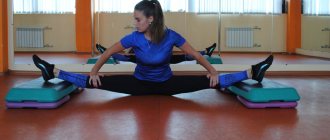The Fullbody training program is well suited for beginners. Fullbody involves working out the entire body in one session. This allows you to pump one muscle group 2-3 times a week.
This program is not very suitable for professionals because... the muscles do not have time to recover, but for beginners this is just right. A beginner does not have large muscles, so the body of beginners copes with stress and develops.
According to the fullbody program, it is recommended for a beginner to train for about six months, then it is advisable to switch to a three-day split.
Mike Vasquez. Fullbody training program!
Who is this type of training suitable for?
The fullbody program is best suited for beginners, maximizing all areas of the body in one training session. For experienced athletes, this scheme is only suitable for losing weight, since they need to devote a lot of time to each muscle group.
In addition, this type of training implies that each muscle will be worked 2-3 times a week. This is not suitable for professionals, because their muscles will not have time to recover due to high loads. If you reduce the intensity, then in this case they will be of practically no use.
Therefore, the main target audience for this type of training will be beginners, but it is also suitable for girls and women. To effectively load the muscles, they need to do a much smaller amount of work. This system should be followed for at least the first six months of classes, gradually moving to a classic, three-day split.
What is fullbadi training and its features
Translated from English, “full body” literally means “whole body,” which is what her technique says - working out the whole body in one workout.
Typically, trainers recommend this type of training for beginners, that is, people whose muscles and ligaments are not yet ready for intense power loads. Thanks to performing 2 exercises per muscle group, and not 4-6, as in split training, untrained muscles do not overwork and have time to recover without receiving excessive microtrauma.
Recent studies have confirmed that such training 2-3 times a week helps to get and maintain excellent physical shape, without excessive strength loads, but this will take a little more time.
Also, this training method is suitable for girls, taking into account the characteristics of the female body, for which it is better to perform a couple of exercises on the legs in each workout, supplementing the program with exercises that involve all the muscles of the body at one time.
An important feature of the training is that the program consists mainly of multi-joint exercises, which are also called basic. In such exercises, at least two joints are simultaneously worked, and isolating exercises are included in the program less frequently.
Rules for creating a program and types of exercises
If you need to create a program yourself and generally understand its principle, follow these simple rules:
- During one workout, one muscle group should perform no more than three exercises.
- The program should consist of 6 main exercises, one exercise from each type, namely:
- Hip-dominant - the main or dominant is the hip joint, such exercises include deadlifts and Romanian deadlifts, hyperextensions and the like.
- Knee-dominant - that is, the knee joint is dominant, namely in exercises such as squats, lunges and the like.
- Horizontal presses are exercises such as push-ups and all kinds of barbell and dumbbell presses at different angles.
- Vertical presses - namely standing presses and exercises that turn the shoulder outward, such as pull-downs and dumbbell lateral raises.
- Vertical rows – these include all types of pull-ups and vertical block rows.
- Horizontal rows are rows of barbells and dumbbells in a bent position, as well as rows of blocks in a horizontal position.
- You can optionally add 1-2 exercises for biceps, triceps or lower legs.
- At the end of the complex, 2-3 exercises are performed on the abdominal muscles; select any techniques according to the degree of difficulty; they do not have to be changed every workout, unlike the main part.
- On average, 2-4 approaches are performed in each exercise, it all depends on the preparation.
- The training duration is no more than one hour.
- It is necessary to perform 3 workouts per week - 1 microcycle, but no more than 4 workouts, preferably every other day.
- At the beginning of the training, the most difficult exercises of the first type should be performed - knee- and pelvic-dominant, number one and two. Each subsequent set should consist of easier exercises, with the easiest ones at the end.
- Rest between sets averages 2 minutes.
- Each week, try to reduce the number of repetitions by adding more weight. For example, the first week - 20,15,12,10 repetitions, the second week - 15,12,10, 8, the third - 12,10,8,6, the fourth - 10,8,6,4.
Examples of exercises that can be added to a training program
Knee-dominant
- Squats.
- Squats with dumbbells.
- Lunges of all kinds.
- Farmer's walk.
- Front squats.
- Hack machine.
- Squats in Smith.
- Lunges in Smith.
- Sumo squats.
- Leg extension.
Pelvic-dominant
- Deadlift.
- Romanian cravings.
- Hyperextension.
- Swing your legs in a simulator and crossover.
- Leg bending in the simulator.
Horizontal presses
- Bench press with a barbell.
- Press with a barbell at an angle of 30 and 45 degrees.
- Close grip press.
- Pushups.
- Reverse push-ups.
- Horizontal press with dumbbells.
- Incline dumbbell press.
- Dumbbell flyes lying horizontally and at an angle.
Vertical rods
- Wide grip pull-ups behind the bar.
- Pull-ups to the chest.
- Reverse grip pull-ups.
- All types of vertical block rods.
Vertical presses
- Standing dumbbell press.
- Barbell press or overhead Smith.
- Barbell press or Smith press in front of you.
- Arnold press.
- Dumbbell raises to the sides.
- Barbell row to the chin.
- Front swings.
Horizontal rods
- Horizontal block row with a narrow and wide grip (rear delta).
- Bent-over barbell row.
- Bent-over dumbbell rows.
- Row of one dumbbell in support.
- Lever rod.
- T-bar.
- Pull-ups on a low bar or with TRX.
Of course, it would be correct if at the end of the blocks you add isolating exercises for the biceps, triceps and lower legs, so look at your well-being and muscle development.
Triceps
- Triceps in the upper block of the crossover.
- Extension of arms with dumbbells from behind the head.
- One-arm dumbbell extension from behind the head.
- Extension of the crossover block from behind the head.
- Bent over arm extension with dumbbells.
- French press.
Biceps
- Curling arms with a barbell with various grips.
- Curling arms with dumbbells - together or alternately.
- Curling arms with dumbbells in supination.
- Hammer.
- Concentrated dumbbell lift.
- Bending arms from the lower block of the crossover.
- Bending arms in the simulator.
Shin
- Shin in a sitting machine.
- Donkey.
- Calf raise in Smith.
- Calf raise with dumbbells on one leg.
Read more about the calf raise exercise →
Press
- Crunches on the floor – full and short.
- Crunches on a bench and a Roman chair.
- Lying leg raises.
- Hanging leg raises - on uneven bars or a crossbar.
- Bike.
- Diagonal twists in all variations.
- Crunches in a block machine.
- "Prayer" in a crossover.
At the end of the workout, you can do ten minutes of cardio to cool down and be sure to stretch all the muscles of the body after the exercise.
The benefits and harms of fullbody training
Fullbody style training allows you to develop your entire body evenly. With their help, you can build up a basic “reserve” of muscle mass, which you will develop and strengthen later.
They are suitable not only as intensive programs for training in the gym, but also for those who want to exercise effectively at home. That is, you don’t have to plunge headlong into the world of sports - such a system will give you a chance to keep your body healthy and strong.
Training different muscle groups on the same day is perceived by the body as serious stress. When you train your chest, legs, and back in one session, this actively stimulates your metabolism. As a result, such workouts are very good for losing weight.
Such an integrated approach can only cause harm if you seriously violate the technique of performing an exercise, or if you train too often, not allowing the body to recover.
Pros and cons of fullbadi
The following benefits of training can be highlighted:
- The training is suitable for beginners and is correct for an unprepared body, as well as for regaining shape after a long rest and subsequently rehabilitation after injuries.
- The workout is suitable for both men and girls.
- Fulbadi is also suitable for professional bodybuilders in the off-season to maintain shape after competitions.
- An ideal workout for women of all ages.
- Thanks to adequate load, each muscle is trained properly, but is not unnecessarily injured, having time to recover for the next workout.
- The risk of overtraining and the development of severe inflammation in the muscles the next day is reduced.
- Better for beginners than a split system.
- Allows you to strengthen muscles and also get rid of excess fat.
- A safer method for strengthening ligaments and muscles.
Flaws:
- Although this is not a disadvantage, this method is still not suitable and ineffective for experienced gym goers who require complex split training to progress.
- Despite the fact that the training is designed for beginners, it is still not worth doing it in the first month, since it is not advisable for unprepared people to perform complex basic exercises.
Technique and types of exercises
Exercises in such training can be very different. Starting from the classic bench press to jumping rope. They are selected based on what goals you are pursuing.
Men in the gym should pay the most attention to basic exercises - bench press, squat and deadlift. They are a key point in all strength training, and it is on them that muscle mass gain primarily depends.
If you came to the gym to lose weight, then cardio loads should be the basis of your fullbody workouts. It is best to insert them at the beginning and end of the session - this way, the fat burning potential will increase significantly.
Girls rarely train to gain serious muscle mass. Therefore, for representatives of the fair sex, it is recommended to focus on isolated exercises, with a moderate addition of cardio to the program.
For such training, exercises from both classical fitness and crossfit programs, or plyometrics, are suitable. They can be performed either with the use of weights, for example, with dumbbells, with a kettlebell, or with a barbell, or without it.
Fullbody program for beginners
Monday
- Bench press on a horizontal bench 4 sets 12-10-8-6 reps
- Pull-ups 3 sets 10-8-6 reps
- Leg extensions in the simulator 3 sets 12-10-8 reps
- Dumbbell swings to the sides 3 sets 12-10-8 reps
- Cable arm extensions 3 sets 12-10-8 reps
- Barbell Curls 3 sets 10-8-6 reps
- Incline Crunches 3 sets 20-15-10 reps
Wednesday
- Deadlift 4 sets 12-10-8-6 reps
- Incline Dumbbell Press 3 sets 10-8-6 reps
- Leg curls in the simulator 3 sets 12-10-8 reps
- Bent-over dumbbell swings 3 sets 12-10-8 reps
- Close grip bench press 3 sets 10-8-6 reps
- Scott Bench Curls 3 sets 12-10-8 reps
- Hanging leg raises 3 sets to failure
Notes: If you have spinal problems, perform bent-over rows instead of deadlifts.
Friday
- Barbell squats 4 sets 12-10-8-6 reps
- Dips 3 sets 10-8-6 reps
- Lat Pulldown 3 sets 10-8-6 reps
- Seated barbell or dumbbell press 3 sets 10-8-6 reps
- Standing French Press 3 sets 12-10-8 reps
- Reverse grip barbell curls 3 sets 12-10-8 reps
- Seated or standing calf raises 3 sets 20-15-10 reps
Training Tips
As a rule, you need to perform the complex for the whole body three to four times a week. Build your lesson so that the emphasis on different muscle groups is different. In other words, on the first day of training, focus on your pecs. To do this, add the bench press and some other chest exercise to the program, and dilute it with one exercise for other parts of the body, but without adding other basic ones.
In the next workout, the emphasis is on the legs - squats with a barbell, but without adding deadlifts and bench presses. And so on. That is, you do not need to complete the entire base in one workout.
In home training, of course, you can’t get too creative with the exercises, but the goals here are different. It is preferable to exercise at home if you just want to keep your body in good shape. To do this, you can perform the same complexes, but subject to increasing loads.
Sets and reps
Most often, fullbody training is measured in “circles.” That is, you take a certain list of exercises and perform them one after another, without rest. After you have completed one such circle, you can allow yourself a short rest of 2-4 minutes. Then the circle repeats.
In one workout you need to perform from 4 to 10 such circles, depending on your level of training, your goals and the selected exercises.
Warm-up and stretching
Of course, do not forget that you need to thoroughly stretch your entire body before training. Since each of your muscle groups will take part in the work in one session, you need to ensure that all muscles and joints are well warmed up.
The same applies to stretching after training. It will help eliminate lactic acid and toxins from your muscles faster. This helps reduce pain and reduces the time the body needs to recover.
Nutrition and sports supplements
Sets of physical exercises for individual muscles are rarely too tiring. However, to get more benefits from this type of training, I recommend that you use some sports supplements.
For example, consuming BCAA amino acids and protein will never be superfluous. They will allow the body to recover faster and promote better muscle mass gain.
There is no point in talking about nutrition separately for fullbody training. The basic aspects here are the same as with any other type of training. That is, an emphasis on proteins for weight loss, and an emphasis on carbohydrates, and then proteins for gaining muscle mass.
How often to exercise
Ideally, do this type of training 3-4 times a week so that your body has time to recover. Weekly sessions should be alternated, using other exercises and changing days to pump different parts of the body.
Basic option for beginners
Mon, Wed, Fri
- Barbell squats 2-3 sets 8-12 reps
- Bench press 2-3 sets 8-12 reps
- Pull-ups on the bar 2-3 sets 8-15 reps
- Dips 2-3 sets 8-15 reps
- Crunches 3 sets 20-25 reps
Notes: If you have back problems, perform leg presses instead of barbell squats. You can also replace pull-ups with lat pull-downs if you can't do the required number of reps on the bar. Dips can be replaced with barbell presses with a narrow grip.
Common mistakes
The most common mistake in this type of training is either training too often or training too “easy”. In the first case, you will simply overload your body, and it will not have time to recover. In this case, further studies will only be to your detriment.
In the second case, some beginners like to indulge themselves. An extra few minutes of rest, or a break during the circle - remember, you are not working for someone, but first of all for yourself. Namely, there should be the strictest demand from yourself.
Benefits of splitting
Joel Marin also puts forward 3 reasons in favor of a split:
- The less fatigue, the more weight you can train with : when working out according to the full body program, it will not be easy for trainees to perform multi-joint exercises following each other at full strength. An athlete will not be able to perform at full strength on the overhead press when they previously performed a heavy bench press and thereby loaded the anterior deltoid muscles. Therefore, by training each muscle separately with heavier weights on different training days, you can achieve greater muscle overload, which will lead to better muscle growth and strength.
- More Focus on a Single Muscle Group : Needless to say, by training two muscle groups per workout instead of the entire body, those two muscle groups will receive much more attention than the entire body at once. Despite all the benefits of full body training, only through splits can you achieve targeted development of each muscle group.
- Less chance of overtraining : training the whole body is more exhausting than training 1-2 muscle groups. Exercising for a long time using the fullbody system without proper rest can quickly lead to overtraining [2].


